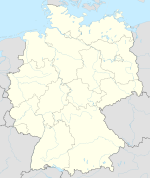Sater friezes
Location of the Saterland in Germany |
The Sater Frisians are one of the smallest language groups in Europe. They belong to the eastern branch of the Frisian ethnic group and are therefore a recognized minority in Germany. You live in the Saterland (saterfries. Seelterlound ), a municipality in the northern district of Cloppenburg ( Lower Saxony ).
The Sater Frisians are descended from East Frisians who left their old homeland around the year 1200 after several storm surges and settled today's Saterland. There they overlaid and assimilated the sparsely resident Westphalian-Saxon indigenous population. An event in May 1400 proves that they clearly belong to the Frisians: Together with the other East Frisian rulers and rural communities, they signed an agreement with representatives of the Hanseatic League that they would no longer give any help to the Vitalienbrothers , pirates active in the North Sea . In a document from this time, the Sater Frisians also described themselves as belonging to the seven Frisian Zealand countries.
What is special about today's Sater Frisians is that they were the last Frisians in eastern Friesland to keep the old Frisian language . About 1000 to 2500 people speak a Frisian dialect interspersed with Lower Saxon elements, Sater Frisian . A study by the University of Göttingen shows 2250 people. According to another source, Saterland Frisian is only spoken by around 1,000 people.
The villages in which the language can still be heard are Ramsloh , Scharrel , Strücklingen and Sedelsberg in the municipality of Saterland. The corresponding place-name signs are bilingual with the Sater Frisian names Roomelse , Skäddel , Strukelje and Sedelsbierich .
It is not very easy to define who exactly is a Sater Frieze. It is undisputed with the "language Frisians". The indigenous population who no longer speak Frisian can also count as Frisian, but today a high proportion of the immigrant population also lives in Saterland. Nonetheless, in Germany it is free to admit to belonging to a minority. Accordingly, everyone is a Sater Frieze who describes himself as such.
The Sater Frisians are one of the few Frisians who are traditionally Catholic . During the Reformation they switched to Protestantism , but were re-Catholicized after the Peace of Westphalia because they belonged to the diocese of Münster .
The Heimatverein “Seelter Bund” takes care of the cultural concerns of the Sater Frisians and the preservation of the language. In addition to the Sater Frisian seal with the image of Charlemagne, it also includes the colors and water lilies of the flag of the Dutch province of Friesland in its coat of arms . This is to expressly emphasize the belonging to the overall Frisian culture.
In the Inter-Frisian Council , Saterland is represented in the East section together with East Frisia , Oldenburg Friesland and other Frisian areas of Lower Saxony.
literature
- Annette Heese: Das Saterland - A foray through the history of the municipality of Saterland, Saterland 1988, ISBN 3-9801728-0-5
- Hanne Klöver: Searching for traces in Saterland: A reader on the history of a community of Frisian origin in the Oldenburger Land , SKN Druck & Verlag GmbH & Co., Saterland 1998, ISBN 3-928327-32-1
- Sater Frisian folk life: texts a. Certificates from d. fries. Saterland with Hochdt. Übers. / Marron C. Fort [Ed.]. Rhauderfehn: Ostendorp, 1985, ISBN 3-921516-42-0
- Sater Frisian voices: texts and testimonies from d. fries. Saterland with Hochdt. Übers. / Marron C. Fort [Ed.]. Rhauderfehn: Ostendorp, 1990, ISBN 3-921516-48-X
Individual evidence
- ↑ Annette Heese: Das Saterland - A foray through the history of the municipality of Saterland, Saterland 1988, ISBN 3-9801728-0-5 , p. 27
- ↑ http://www.deutschlandradiokultur.de/alle-zwei-woche-stirbt-eine-sprache-drang-zur-sprachlichen.1013.de.html?dram:article_id=346343
